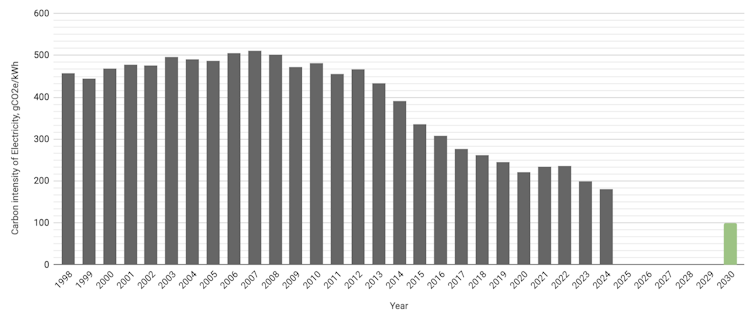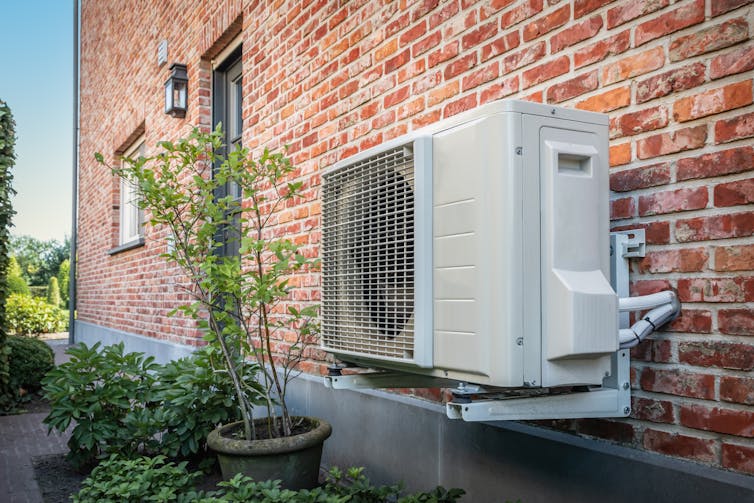
Labour won the 2024 general election with a promise to make the UK “a clean energy superpower”. Part of that vision is the creation of Great British Energy, a public company that will strive to achieve zero-carbon electricity production by 2030 (just over one parliamentary term away).
Achieving this target will be a symbolic step towards addressing the complex challenges of climate change. Decarbonisation will require most of the economy to be run on electricity, so a zero-carbon electricity system is fundamental.
Labour hopes that developing more wind, solar and nuclear power will secure the future of the UK’s energy supply and reduce bills, since wind and solar power are significantly cheaper than gas.
Sounds good. So can the government do it?
Halfway there?
Labour takes power at the midpoint of a rapid decarbonisation of the electricity grid. In ten years, coal has fallen from 30% of supply to less than 1% – with the last ever coal delivery to a UK power station being made just before the election.
Wind and solar, which provide more than 28% of the UK’s electricity, will soon overtake gas as the main generation source as more wind farms come online.
National Grid, the UK’s electricity system operator, is on the verge of being able to run the grid with no fossil fuel power stations, with the help of more than 160 large battery sites. This would be a significant technical achievement, and something that was in planning well before Labour’s election victory.
The transition is evident in the carbon emissions of electricity, which is now within touching distance of the magic 100gCO₂e/kWh (greenhouse gases equivalent to 100 grams of carbon dioxide for each kilowatt-hour of electricity generated over a year). This was the target the government’s policy advisers, the Committee on Climate Change, recommended in the fifth carbon budget. The carbon intensity of UK electricity peaked in the mid-2000s at above 400g/kWh
All this makes Labour’s 2030 target seem, on the surface, very achievable.

Filling the gaps without gas
For the electricity industry, however, the hardest part of the transition is just starting. Labour is aiming to remove gas from the power system twice as fast as the Conservatives removed coal – but it is not just speed that is needed.
True zero-carbon electricity means no emissions from energy generation during each hour of the year. A simulation of the UK electricity system by the thinktank MyGridGB found that tripling the amount of wind and solar generation, installing 250 very large battery storage farms and commissioning nuclear plant Hinkley C would have delivered 90% of electricity from low-carbon sources over the month of May 2024 (an increase from 65%).
Even with all these extra renewables, the grid would need something to fill the gaps when batteries were flat and wind was low. At the moment, that role is typically filled by gas power stations that can be fired up at short notice.
Filling these gaps in a low-carbon way will require energy storage, low-carbon generators that can be turned on when needed (low-carbon biomass plants, for example) or gas power stations with carbon capture and storage. It is unclear what the industry sees as the breakthrough technology – and the grid may well need gas to keep the lights on in the short to medium term.
Due mostly to regulatory and planning barriers, the grid is also being upgraded slower than new generation projects can be developed. This means that developers of new renewables are struggling to find grid connections.
The new chancellor has signalled that grid investment may well be the focus of Great British Energy. Transmission and distribution monopolies will need to be regulated differently or be reformed to stimulate that investment.
The power system is already showing signs of strain as more and more of the country’s transport, industry and heating and cooling is electrified. As such, Labour must look at the electricity demand of tomorrow, which will be much higher than today, when aiming for its 2030 target.
Homes are central to decarbonisation
Even if Labour achieves its 2030 target in the power sector, full decarbonisation will still be a long way off. Britain’s 27 million homes are where a large chunk of national emissions could be removed – and quickly.
The technologies are numerous: low-carbon heating (electric heat pumps, for instance), solar panels, electric vehicle chargers, batteries and energy-efficiency improvements like insulation. Geothermal energy, which involves pumping heat from underground, could also reduce emissions and dependency on imported gas. Solar panels can provide power directly to the home in the day and heat pumps are over three times more efficient than combi boilers. Combined, they can slash the energy that households need to buy each year (by around 40% for an average home).

These technologies can be deployed quickly to rapidly cut emissions. Solar panels, batteries and heat pumps can be installed in days. Their installation also creates skilled jobs across the country. Labour could stimulate Britain’s largest construction site, with millions of homes being transitioned to low-carbon energy each year.
Sadly, there are few examples of effective policies for supporting decarbonisation in communities and homes. Indeed, at least nine policies have been designed that failed to deliver insulation and low-carbon heat in homes. Perhaps the various mayors and devolved assemblies might find and prove local solutions that could then be adopted nationally.
Labour’s goal for a decarbonised power grid is probably achievable against current electricity demand. The past ten years have proven that the UK can quickly build lots of renewables. But successive governments have failed to achieve the same result in homes and communities where so much high-carbon gas is burned, despite their decarbonisation being critical to net zero. It is essential that the decarbonisation of homes is a significant part of the mandate of Great British Energy.
Andrew Crossland has a consultancy agreement with SolarZero, a supplier of residential solar and battery technology in New Zealand.
Jon Gluyas is a founder and shareholder of Snowfox Discovery Ltd (a hydrogen exploration company), Geoenergy Durham Ltd (an energy transition consultancy) and Geoptic Ltd (a company that includes monitoring stored CO2). He is a founder and director of not-for-profit UK National Geothermal Centre. Jon has received funding from the UK government, research councils and industry to work on the energy transition and net zero.
This article was originally published on The Conversation. Read the original article.







